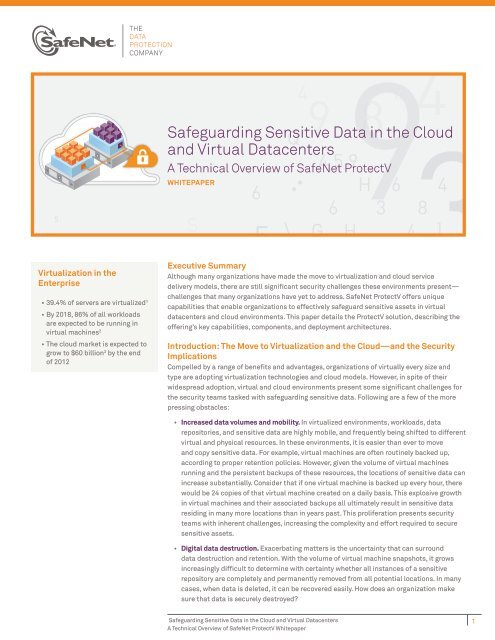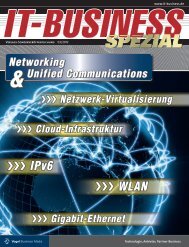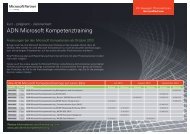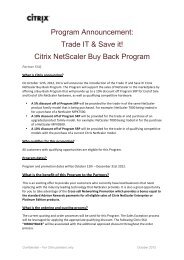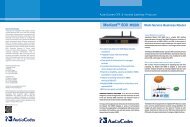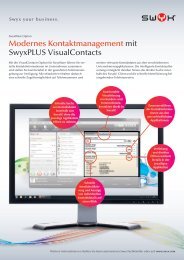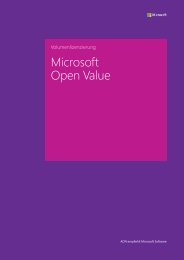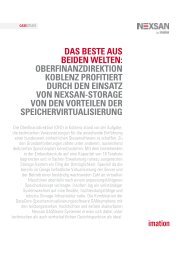Safeguarding Sensitive Data in the Cloud and Virtual ... - ADN
Safeguarding Sensitive Data in the Cloud and Virtual ... - ADN
Safeguarding Sensitive Data in the Cloud and Virtual ... - ADN
You also want an ePaper? Increase the reach of your titles
YUMPU automatically turns print PDFs into web optimized ePapers that Google loves.
<strong>Virtual</strong>ization <strong>in</strong> <strong>the</strong><br />
Enterprise<br />
• 39.4% of servers are virtualized1 • By 2018, 86% of all workloads<br />
are expected to be runn<strong>in</strong>g <strong>in</strong><br />
virtual mach<strong>in</strong>es2 • The cloud market is expected to<br />
grow to $60 billion3 by <strong>the</strong> end<br />
of 2012<br />
<strong>Safeguard<strong>in</strong>g</strong> <strong>Sensitive</strong> <strong>Data</strong> <strong>in</strong> <strong>the</strong> <strong>Cloud</strong><br />
<strong>and</strong> <strong>Virtual</strong> <strong>Data</strong>centers<br />
A Technical Overview of SafeNet ProtectV<br />
whITEpapEr<br />
Executive Summary<br />
Although many organizations have made <strong>the</strong> move to virtualization <strong>and</strong> cloud service<br />
delivery models, <strong>the</strong>re are still significant security challenges <strong>the</strong>se environments present—<br />
challenges that many organizations have yet to address. SafeNet ProtectV offers unique<br />
capabilities that enable organizations to effectively safeguard sensitive assets <strong>in</strong> virtual<br />
datacenters <strong>and</strong> cloud environments. This paper details <strong>the</strong> ProtectV solution, describ<strong>in</strong>g <strong>the</strong><br />
offer<strong>in</strong>g’s key capabilities, components, <strong>and</strong> deployment architectures.<br />
Introduction: The Move to <strong>Virtual</strong>ization <strong>and</strong> <strong>the</strong> <strong>Cloud</strong>—<strong>and</strong> <strong>the</strong> Security<br />
Implications<br />
Compelled by a range of benefits <strong>and</strong> advantages, organizations of virtually every size <strong>and</strong><br />
type are adopt<strong>in</strong>g virtualization technologies <strong>and</strong> cloud models. However, <strong>in</strong> spite of <strong>the</strong>ir<br />
widespread adoption, virtual <strong>and</strong> cloud environments present some significant challenges for<br />
<strong>the</strong> security teams tasked with safeguard<strong>in</strong>g sensitive data. Follow<strong>in</strong>g are a few of <strong>the</strong> more<br />
press<strong>in</strong>g obstacles:<br />
• Increased data volumes <strong>and</strong> mobility. In virtualized environments, workloads, data<br />
repositories, <strong>and</strong> sensitive data are highly mobile, <strong>and</strong> frequently be<strong>in</strong>g shifted to different<br />
virtual <strong>and</strong> physical resources. In <strong>the</strong>se environments, it is easier than ever to move<br />
<strong>and</strong> copy sensitive data. For example, virtual mach<strong>in</strong>es are often rout<strong>in</strong>ely backed up,<br />
accord<strong>in</strong>g to proper retention policies. However, given <strong>the</strong> volume of virtual mach<strong>in</strong>es<br />
runn<strong>in</strong>g <strong>and</strong> <strong>the</strong> persistent backups of <strong>the</strong>se resources, <strong>the</strong> locations of sensitive data can<br />
<strong>in</strong>crease substantially. Consider that if one virtual mach<strong>in</strong>e is backed up every hour, <strong>the</strong>re<br />
would be 24 copies of that virtual mach<strong>in</strong>e created on a daily basis. This explosive growth<br />
<strong>in</strong> virtual mach<strong>in</strong>es <strong>and</strong> <strong>the</strong>ir associated backups all ultimately result <strong>in</strong> sensitive data<br />
resid<strong>in</strong>g <strong>in</strong> many more locations than <strong>in</strong> years past. This proliferation presents security<br />
teams with <strong>in</strong>herent challenges, <strong>in</strong>creas<strong>in</strong>g <strong>the</strong> complexity <strong>and</strong> effort required to secure<br />
sensitive assets.<br />
• Digital data destruction. Exacerbat<strong>in</strong>g matters is <strong>the</strong> uncerta<strong>in</strong>ty that can surround<br />
data destruction <strong>and</strong> retention. With <strong>the</strong> volume of virtual mach<strong>in</strong>e snapshots, it grows<br />
<strong>in</strong>creas<strong>in</strong>gly difficult to determ<strong>in</strong>e with certa<strong>in</strong>ty whe<strong>the</strong>r all <strong>in</strong>stances of a sensitive<br />
repository are completely <strong>and</strong> permanently removed from all potential locations. In many<br />
cases, when data is deleted, it can be recovered easily. How does an organization make<br />
sure that data is securely destroyed?<br />
<strong>Safeguard<strong>in</strong>g</strong> <strong>Sensitive</strong> <strong>Data</strong> <strong>in</strong> <strong>the</strong> <strong>Cloud</strong> <strong>and</strong> <strong>Virtual</strong> <strong>Data</strong>centers<br />
A Technical Overview of SafeNet ProtectV Whitepaper<br />
1
ProtectV is a virtual server-based<br />
solution, which enables it to<br />
adapt to <strong>the</strong> fluidity of virtual<br />
environments.<br />
• adm<strong>in</strong>istrative exposure. Ano<strong>the</strong>r potential challenge is posed by <strong>the</strong> chang<strong>in</strong>g dynamics<br />
of adm<strong>in</strong>istration <strong>in</strong> virtualized environments. Compared to prior comput<strong>in</strong>g models,<br />
cloud <strong>and</strong> virtualization ultimately <strong>in</strong>troduce more privileged users <strong>and</strong> a new class of<br />
adm<strong>in</strong>istrators. Typically, teams of adm<strong>in</strong>istrators focused on servers, storage, backups,<br />
<strong>and</strong> applications will have some level of access <strong>in</strong> virtual environments, <strong>and</strong> quite often<br />
security policies <strong>and</strong> adm<strong>in</strong>istrative functions are h<strong>and</strong>led <strong>in</strong>dependently by each<br />
group. Fur<strong>the</strong>r, companies who use <strong>the</strong> public cloud will have <strong>the</strong>ir data h<strong>and</strong>led by<br />
adm<strong>in</strong>istrators who usually work for <strong>the</strong> cloud provider, not for <strong>the</strong> company itself. These<br />
adm<strong>in</strong>istrators must be able to move <strong>the</strong> data but not be able to view or access it.<br />
Introduc<strong>in</strong>g SafeNet protectV<br />
Today, SafeNet ProtectV enables organizations to leverage <strong>the</strong> bus<strong>in</strong>ess benefits of<br />
virtualization <strong>and</strong> cloud services, while help<strong>in</strong>g to meet <strong>the</strong>ir governance, compliance, <strong>and</strong><br />
data protection requirements. With ProtectV, organizations can encrypt <strong>and</strong> secure entire<br />
virtualized mach<strong>in</strong>es, protect<strong>in</strong>g <strong>the</strong>se assets from <strong>the</strong>ft or exposure. Fur<strong>the</strong>r, with ProtectV,<br />
security teams can encrypt virtual storage, ensur<strong>in</strong>g cloud data is isolated <strong>and</strong> secured—even<br />
<strong>in</strong> shared, multi-tenant cloud environments. ProtectV can be deployed <strong>in</strong> public clouds, private<br />
clouds, <strong>and</strong> virtual datacenters.<br />
ProtectV is a virtual server-based solution, which enables it to adapt to <strong>the</strong> fluidity of virtual<br />
environments. At <strong>the</strong> same time, ProtectV is seamlessly <strong>in</strong>tegrated with SafeNet KeySecure,<br />
a high availability, appliance-based key management solution that provides a hardened root<br />
of trust with<strong>in</strong> <strong>the</strong> customer’s premises. With this comb<strong>in</strong>ation, <strong>the</strong> ProtectV solution enables<br />
security teams to enjoy <strong>the</strong>se advantages:<br />
• Leverage <strong>the</strong> deepest, most comprehensive visibility of virtual environments <strong>in</strong> order to<br />
enable effective governance.<br />
• Ensure <strong>the</strong> highest levels of compliance with all relevant policies <strong>and</strong> regulatory<br />
m<strong>and</strong>ates.<br />
• Apply maximum security <strong>and</strong> protection to sensitive data assets <strong>in</strong> virtual environments.<br />
protectV: Key Capabilities<br />
Through its <strong>in</strong>tegration with KeySecure, ProtectV enables organizations to leverage a<br />
hardened appliance for secur<strong>in</strong>g keys, policies, <strong>and</strong> cryptographic process<strong>in</strong>g. At <strong>the</strong> same<br />
time, <strong>the</strong> solution is efficiently deployed <strong>in</strong> highly dynamic virtual <strong>and</strong> cloud environments,<br />
so organizations can reta<strong>in</strong> complete control over keys <strong>and</strong> sensitive assets with<strong>in</strong> <strong>the</strong>ir<br />
premises—while embrac<strong>in</strong>g <strong>the</strong> opportunities provided by virtualization <strong>and</strong> cloud delivery<br />
models.<br />
Follow<strong>in</strong>g are a few of <strong>the</strong> solution’s key capabilities:<br />
• Flexible <strong>in</strong>tegration. ProtectV offers complete support for automated, highly dynamic<br />
virtual environments, which is vital <strong>in</strong> both ensur<strong>in</strong>g critical security mechanisms are<br />
consistently enforced <strong>and</strong> <strong>in</strong> streaml<strong>in</strong><strong>in</strong>g security adm<strong>in</strong>istration. A ProtectV API is<br />
available, which enables flexible <strong>in</strong>tegration <strong>in</strong> cloud <strong>and</strong> virtual environments. With <strong>the</strong><br />
API, organizations can configure a range of comm<strong>and</strong>s, <strong>in</strong>clud<strong>in</strong>g sett<strong>in</strong>g or retriev<strong>in</strong>g<br />
cloud credentials, list<strong>in</strong>g virtual mach<strong>in</strong>es secured, start<strong>in</strong>g or stopp<strong>in</strong>g virtual mach<strong>in</strong>es,<br />
<strong>and</strong> more.<br />
• Extensibility. Through its <strong>in</strong>tegration with KeySecure <strong>and</strong> o<strong>the</strong>r SafeNet security<br />
solutions, ProtectV can support exp<strong>and</strong>ed cryptographic services. Consequently, <strong>the</strong><br />
solution represents an <strong>in</strong>vestment that can be leveraged over <strong>the</strong> long term, even as<br />
<strong>in</strong>frastructures, bus<strong>in</strong>ess objectives, <strong>and</strong> security requirements evolve.<br />
<strong>Safeguard<strong>in</strong>g</strong> <strong>Sensitive</strong> <strong>Data</strong> <strong>in</strong> <strong>the</strong> <strong>Cloud</strong> <strong>and</strong> <strong>Virtual</strong> <strong>Data</strong>centers<br />
A Technical Overview of SafeNet ProtectV Whitepaper<br />
2
Even if some adm<strong>in</strong>istrators<br />
requires privileges for mov<strong>in</strong>g<br />
or manag<strong>in</strong>g virtual mach<strong>in</strong>es,<br />
security teams can still enforce<br />
policies so that <strong>the</strong>y can’t actually<br />
decrypt <strong>and</strong> access <strong>the</strong> sensitive<br />
data held on those virtual<br />
mach<strong>in</strong>es.<br />
• Scalability <strong>and</strong> high availability. ProtectV <strong>and</strong> KeySecure offer support for failover<br />
<strong>and</strong> replication, which enables organizations to ensure <strong>the</strong> availability <strong>and</strong> scalability<br />
of critical cryptographic process<strong>in</strong>g. Fur<strong>the</strong>r, with this scalability, organizations can<br />
leverage KeySecure across any number of datacenters, cloud deployments, encryption<br />
implementations, <strong>and</strong> regions.<br />
• Complete visibility <strong>and</strong> audit trails. ProtectV provides audit trails for all security<br />
operations, so organizations can ensure compliance with relevant policies <strong>and</strong> m<strong>and</strong>ates,<br />
<strong>and</strong> efficiently demonstrate compliance for auditors.<br />
• Granular security controls. With this solution, organizations can realize granular controls<br />
over data access. For example, even if some adm<strong>in</strong>istrators requires privileges for mov<strong>in</strong>g<br />
or manag<strong>in</strong>g virtual mach<strong>in</strong>es, security teams can still enforce policies so that <strong>the</strong>y can’t<br />
actually decrypt <strong>and</strong> access <strong>the</strong> sensitive data held on those virtual mach<strong>in</strong>es. With<br />
ProtectV, security teams can control where <strong>and</strong> when a virtual mach<strong>in</strong>e can be launched,<br />
<strong>and</strong> by whom.<br />
protectV Components <strong>and</strong> architecture<br />
The ProtectV solution features several components, which are seamlessly <strong>in</strong>tegrated <strong>and</strong><br />
enable streaml<strong>in</strong>ed deployment. Follow<strong>in</strong>g is an overview of each component.<br />
ProtectV Clients<br />
• where deployed. ProtectV Clients are deployed <strong>in</strong> <strong>the</strong> cloud or virtual environments, where<br />
<strong>the</strong>y protect virtual mach<strong>in</strong>es.<br />
• who accesses. The virtual mach<strong>in</strong>es protected by ProtectV Client are accessed directly by<br />
users. ProtectV Client can only be accessed by ProtectV Manager <strong>and</strong> its adm<strong>in</strong>istrators.<br />
• Functionality delivered. Offer<strong>in</strong>g support for W<strong>in</strong>dows <strong>and</strong> L<strong>in</strong>ux environments, ProtectV<br />
Clients enable a range of cryptographic capabilities. These clients enable encryption<br />
with<strong>in</strong> both system <strong>and</strong> volume partitions. Fur<strong>the</strong>r, <strong>the</strong>y enable encryption that is<br />
completely transparent to associated applications. ProtectV Client also is responsible for<br />
monitor<strong>in</strong>g security processes.<br />
ProtectV Manager<br />
• where deployed. ProtectV Manager is also deployed with<strong>in</strong> <strong>the</strong> cloud or virtual<br />
environment <strong>in</strong> which encryption is employed. When deployed <strong>in</strong> Amazon Web Services<br />
environments, ProtectV Manager is deployed on a virtual mach<strong>in</strong>e that is launched us<strong>in</strong>g<br />
an AWS Amazon Mach<strong>in</strong>e Image (AMI). This component is also deployed on a virtual<br />
mach<strong>in</strong>e us<strong>in</strong>g an ISO image with<strong>in</strong> VMware environments.<br />
• who accesses. Only authorized personnel, such as <strong>the</strong> ProtectV adm<strong>in</strong>istrator, <strong>the</strong><br />
helpdesk adm<strong>in</strong>istrator, or <strong>the</strong> owner of <strong>the</strong> VM, can <strong>in</strong>teract with ProtectV Manager.<br />
• Functionality delivered. ProtectV Manager delivers a central management console that<br />
enables adm<strong>in</strong>istrators to configure, manage, <strong>and</strong> report on cryptographic activities.<br />
ProtectV Manger offers such capabilities as key cach<strong>in</strong>g, policy enforcement, <strong>and</strong> log<br />
aggregation. The connection between ProtectV Manager <strong>and</strong> <strong>the</strong> ProtectV Clients is<br />
secured. The ProtectV Manager also manages <strong>the</strong> encryption of resources. By centraliz<strong>in</strong>g<br />
all <strong>the</strong>se capabilities, ProtectV Manager enables security teams to adm<strong>in</strong>ster <strong>the</strong>se<br />
processes <strong>in</strong> an efficient, highly scalable manner.<br />
<strong>Safeguard<strong>in</strong>g</strong> <strong>Sensitive</strong> <strong>Data</strong> <strong>in</strong> <strong>the</strong> <strong>Cloud</strong> <strong>and</strong> <strong>Virtual</strong> <strong>Data</strong>centers<br />
A Technical Overview of SafeNet ProtectV Whitepaper<br />
3
KeySecure<br />
• where deployed. KeySecure is deployed with<strong>in</strong> <strong>the</strong> customer’s premises.<br />
• who accesses. KeySecure is controlled by <strong>the</strong> key management adm<strong>in</strong>istrator.<br />
• Functionality delivered. KeySecure can be used to manage <strong>the</strong> lifecycle of all keys <strong>and</strong><br />
key types, across one or all datacenters as well as private <strong>and</strong> public cloud deployments.<br />
KeySecure stores keys with<strong>in</strong> a hardened appliance that is FIPS 140-2 level 3 compliant,<br />
which means it has been certified to <strong>the</strong> most rigorous st<strong>and</strong>ards for its tamper<br />
resistance <strong>and</strong> security safeguards. KeySecure can work directly with <strong>the</strong> enterprise<br />
certificate authority (CA) to ensure trusted digital transactions. By act<strong>in</strong>g as a central<br />
facility for all sensitive key activity, <strong>and</strong> logg<strong>in</strong>g <strong>and</strong> securely stor<strong>in</strong>g this <strong>in</strong>formation,<br />
KeySecure provides a range of capabilities for support<strong>in</strong>g audit<strong>in</strong>g, report<strong>in</strong>g, <strong>and</strong><br />
compliance requirements.<br />
Key Lifecycle<br />
Management<br />
Org Adm<strong>in</strong><br />
Key Mgmt<br />
Adm<strong>in</strong><br />
KeySeure<br />
On-Premise<br />
Enterprise CA<br />
<strong>Safeguard<strong>in</strong>g</strong> <strong>Sensitive</strong> <strong>Data</strong> <strong>in</strong> <strong>the</strong> <strong>Cloud</strong> <strong>and</strong> <strong>Virtual</strong> <strong>Data</strong>centers<br />
A Technical Overview of SafeNet ProtectV Whitepaper<br />
ProtectV Client<br />
Client Crypto<br />
Servcies Provider<br />
ProtectV Manager<br />
<strong>Cloud</strong> IaaS<br />
Management<br />
Console<br />
ProtectV Adm<strong>in</strong><br />
VM User<br />
VM Adm<strong>in</strong><br />
4
The Importance of Protect<strong>in</strong>g<br />
Cryptographic Keys<br />
“As <strong>the</strong> use of encryption<br />
grows <strong>and</strong> various solutions<br />
are deployed, key management<br />
becomes exponentially critical<br />
<strong>and</strong> complex. Mismanagement of<br />
keys can expose an organization<br />
to unnecessary risks.”<br />
~Gartner<br />
Unparalleled protection of Cryptographic Keys<br />
Through its capabilities <strong>and</strong> deployment architecture, <strong>the</strong> ProtectV solution ensures that vital<br />
cryptographic keys are strongly secured at all times. Follow<strong>in</strong>g are a few of <strong>the</strong> solution’s key<br />
management safeguards:<br />
• Logical separation. Cryptographic keys are stored separately from virtual servers. With<br />
this logical separation of keys, organizations can ensure keys are fully secured.<br />
• Obfuscation. Whe<strong>the</strong>r ProtectV Manager is runn<strong>in</strong>g on a virtual server on premise or <strong>in</strong> <strong>the</strong><br />
cloud, keys are obfuscated to ensure key bytes are never exposed to unauthorized use.<br />
• Granular decryption. When an authorized user requests access to encrypted resources,<br />
cryptographic keys reside on KeySecure to enable decryption. In addition, <strong>the</strong> virtual<br />
mach<strong>in</strong>es or <strong>in</strong>stances are never completely decrypted. When a file or o<strong>the</strong>r resource is<br />
requested by <strong>the</strong> user, only <strong>the</strong> specific sector hous<strong>in</strong>g that asset is decrypted.<br />
• Encrypted virtual mach<strong>in</strong>es, keys, <strong>and</strong> snapshots. ProtectV fully leverages encryption<br />
across <strong>the</strong> <strong>in</strong>frastructure. The virtual mach<strong>in</strong>e that ProtectV Manager runs on is encrypted.<br />
Fur<strong>the</strong>r, <strong>the</strong> keys stored <strong>in</strong> <strong>the</strong> ProtectV Manager database are also encrypted. F<strong>in</strong>ally,<br />
snapshots can also be encrypted.<br />
• Secured key transmissions. Keys <strong>in</strong> transit between ProtectV Manager <strong>and</strong> ProtectV<br />
Client are secured via SSL, <strong>and</strong> can even be fur<strong>the</strong>r secured through client certified<br />
au<strong>the</strong>ntication. ProtectV supports both third-party CAs <strong>and</strong> two-way SSL au<strong>the</strong>ntication.<br />
Deployment Scenarios<br />
Whe<strong>the</strong>r <strong>the</strong> ProtectV solution is deployed <strong>in</strong> a virtual datacenter or if it is deployed to secure<br />
sensitive assets <strong>in</strong> a public cloud environment, organizations start by deploy<strong>in</strong>g KeySecure<br />
with<strong>in</strong> ProtectV: a trusted location Deployment with<strong>in</strong> <strong>the</strong>ir Scenario premises. ProtectV - Public Manager <strong>Cloud</strong> <strong>and</strong> ProtectV Clients are<br />
deployed ei<strong>the</strong>r <strong>in</strong> <strong>the</strong> virtual datacenter or <strong>the</strong> public cloud. When deployed, security teams<br />
can effectively ensure that all <strong>the</strong>ir sensitive assets <strong>in</strong> <strong>the</strong> virtual environment are secured.<br />
KeySecure<br />
Trusted On-premise Location<br />
<strong>Safeguard<strong>in</strong>g</strong> <strong>Sensitive</strong> <strong>Data</strong> <strong>in</strong> <strong>the</strong> <strong>Cloud</strong> <strong>and</strong> <strong>Virtual</strong> <strong>Data</strong>centers<br />
A Technical Overview of SafeNet ProtectV Whitepaper<br />
ProtectV Manager<br />
Public <strong>Cloud</strong><br />
ProtectV Client<br />
ProtectV: Deployment Scenario - <strong>Virtual</strong>ized <strong>Data</strong> Center<br />
KeySecure<br />
Trusted On-premise Location<br />
ProtectV Manager<br />
<strong>Virtual</strong>ized <strong>Data</strong> Center<br />
ProtectV Client<br />
5
Deployment Overview<br />
Whe<strong>the</strong>r it is be<strong>in</strong>g deployed <strong>in</strong> virtual datacenters or public cloud environments, ProtectV can<br />
be implemented <strong>in</strong> a straightforward <strong>and</strong> efficient manner.<br />
Follow<strong>in</strong>g is an overview of <strong>the</strong> steps required <strong>in</strong> a typical implementation:<br />
• Set up <strong>the</strong> cloud service provider environment or virtual datacenter.<br />
• Install <strong>and</strong> configure KeySecure for ProtectV Manager <strong>in</strong> a secure on-premise location.<br />
Configuration will <strong>in</strong>clude such efforts as sett<strong>in</strong>g up IP addresses, users, <strong>and</strong> certificates.<br />
• Take a snapshot of a virtual mach<strong>in</strong>e that will be encrypted. This is for backup purposes<br />
only; because this virtual mach<strong>in</strong>e is not encrypted, adm<strong>in</strong>istrators are advised to delete<br />
this snapshot after <strong>the</strong> encryption <strong>in</strong> set.<br />
• Configure ProtectV Manager <strong>in</strong> <strong>the</strong> virtual datacenter or cloud environment.<br />
• Connect ProtectV Manager to KeySecure.<br />
• Create users <strong>and</strong> permissions with<strong>in</strong> ProtectV Manager.<br />
• Install <strong>the</strong> ProtectV Client on new or exist<strong>in</strong>g virtual mach<strong>in</strong>es.<br />
• Encrypt partitions us<strong>in</strong>g ProtectV Manager.<br />
• Run <strong>the</strong> encrypted virtual mach<strong>in</strong>es.<br />
• Test that <strong>the</strong> virtual mach<strong>in</strong>es are secure. This will typically <strong>in</strong>clude <strong>the</strong> follow<strong>in</strong>g<br />
activities:<br />
• Start server from <strong>the</strong> ProtectV Manager console.<br />
• Log <strong>in</strong>.<br />
• Verify read <strong>and</strong> write permissions.<br />
• Perform rout<strong>in</strong>e functions, such as enabl<strong>in</strong>g file shar<strong>in</strong>g, do<strong>in</strong>g a transfer via FTP, or<br />
runn<strong>in</strong>g a database.<br />
• Shut down or restart <strong>the</strong> virtual mach<strong>in</strong>e.<br />
• Verify that unauthorized users can’t access encrypted virtual mach<strong>in</strong>es.<br />
Conclusion<br />
Without effective safeguards <strong>in</strong> place, virtual datacenters <strong>and</strong> cloud environments can present<br />
a host of risks to sensitive data. With ProtectV, organizations can fully exploit <strong>the</strong> benefits<br />
offered by virtualization <strong>and</strong> cloud services, <strong>and</strong> at <strong>the</strong> same time ensure <strong>the</strong>y have <strong>the</strong><br />
visibility <strong>and</strong> control <strong>the</strong>y need to safeguard <strong>the</strong>ir sensitive assets at all times.<br />
SafeNet <strong>Data</strong> protection<br />
<strong>Virtual</strong>ized <strong>and</strong> cloud security solutions, like all enterprise security, need to be managed <strong>in</strong><br />
a layered approach to <strong>the</strong> <strong>in</strong>formation protection lifecycle that comb<strong>in</strong>es encryption, access<br />
policies, key management, content security, <strong>and</strong> au<strong>the</strong>ntication. These layers need to be<br />
<strong>in</strong>tegrated <strong>in</strong>to a flexible framework that allows <strong>the</strong> organization to adapt to <strong>the</strong> risk it faces.<br />
Wherever data resides, SafeNet offers persistent, secured storage for structured <strong>and</strong><br />
unstructured data. SafeNet provides a practical framework for deliver<strong>in</strong>g <strong>the</strong> trust, security,<br />
<strong>and</strong> compliance enterprises dem<strong>and</strong> when mov<strong>in</strong>g data, applications <strong>and</strong> systems to <strong>the</strong><br />
virtualized environments <strong>and</strong> <strong>the</strong> cloud.<br />
<strong>Safeguard<strong>in</strong>g</strong> <strong>Sensitive</strong> <strong>Data</strong> <strong>in</strong> <strong>the</strong> <strong>Cloud</strong> <strong>and</strong> <strong>Virtual</strong> <strong>Data</strong>centers<br />
A Technical Overview of SafeNet ProtectV Whitepaper<br />
6
about SafeNet<br />
Founded <strong>in</strong> 1983, SafeNet, Inc. is one of <strong>the</strong> largest <strong>in</strong>formation security companies <strong>in</strong> <strong>the</strong><br />
world, <strong>and</strong> is trusted to protect <strong>the</strong> most sensitive data for market-lead<strong>in</strong>g organizations<br />
around <strong>the</strong> globe. SafeNet’s data-centric approach focuses on <strong>the</strong> protection of high value<br />
<strong>in</strong>formation throughout its lifecycle, from <strong>the</strong> datacenter to <strong>the</strong> cloud. More than 25,000<br />
customers across commercial enterprises <strong>and</strong> government agencies trust SafeNet to protect<br />
<strong>and</strong> control access to sensitive data, manage risk, ensure compliance, <strong>and</strong> secure virtual <strong>and</strong><br />
cloud environments.<br />
1 siliconANGLE, “Quarterly Index: <strong>Virtual</strong>ization Penetration <strong>in</strong> <strong>the</strong> U.S. <strong>and</strong> Europe”, Alex Williams, July 21, 2011<br />
http://siliconangle.com/blog/2011/07/21/virtualization-penetration-<strong>in</strong>-<strong>the</strong>-u-s-<strong>and</strong>-western-europe/<br />
2 Gartner, “Forecast: x86 Server <strong>Virtual</strong>ization, Worldwide, 2008-2018”, July 2011<br />
3 Forrester Research, “10 <strong>Cloud</strong> Predictions For 2012”, Holger Kisker, December 13, 2011 http://blogs.forrester.com/<br />
holger_kisker/11-12-13-10_cloud_predictions_for_2012<br />
Contact Us: For all office locations <strong>and</strong> contact <strong>in</strong>formation, please visit www.safenet-<strong>in</strong>c.com<br />
Follow Us: www.safenet-<strong>in</strong>c.com/connected<br />
©2012 SafeNet, Inc. All rights reserved. SafeNet <strong>and</strong> SafeNet logo are registered trademarks of SafeNet.<br />
All o<strong>the</strong>r product names are trademarks of <strong>the</strong>ir respective owners. WP (EN)-05.23.12<br />
<strong>Safeguard<strong>in</strong>g</strong> <strong>Sensitive</strong> <strong>Data</strong> <strong>in</strong> <strong>the</strong> <strong>Cloud</strong> <strong>and</strong> <strong>Virtual</strong> <strong>Data</strong>centers<br />
A Technical Overview of SafeNet ProtectV Whitepaper<br />
7


